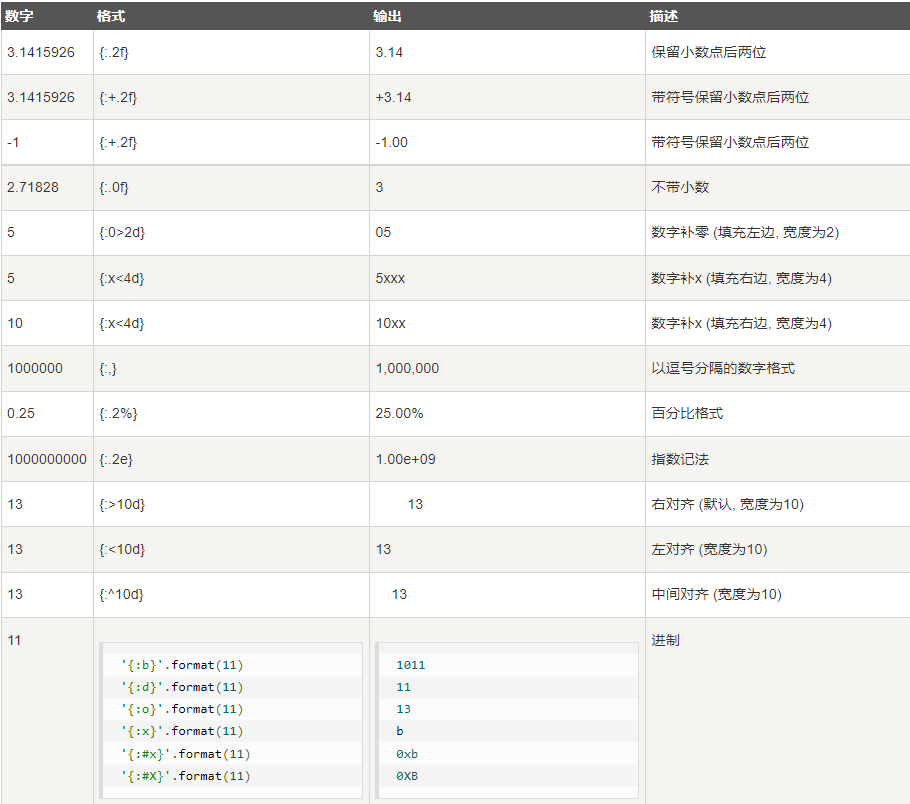Python数据类型:
整数类型: class 'int'
例子:100,200,300,400,00234,0B1001
浮点类型:class 'float'
例子:3.22e3,0.24E6,1.5E-3,5.2
复数类型:class 'complex'
复数必须有表示虚部的实数和j 例子:1j,1+3j,5+4j
布尔类型:
true false 例子:>>>c=bool(b) True
字符串类型:class 'str'
例子:"aa","bbb","c112","G45sfd"
列表类型:class 'list'
例子:[1,2,3,4] ["two","two","python","three"] [3,4,5,"three"]
元组类型:class 'tuple'
例子:('physics','chemistry',125,134)
字典类型:class 'dict'
例子:
Python变量
算数运算符:
加+ , 减- , 乘x , 除/ ,求余% , 求幂** , 整除//
比较运算符:
大于> ,小于< , 大于等于>= , 小于等于<= , 等于== , 不等于!=
逻辑运算符:
逻辑与and , 逻辑或or , 逻辑非not
赋值运算符:
x,y,z=3,4,5 那么x=3,y=4,z=5
复合赋值运算符:
| 运算符 | 功能作用 | 示例 |
|---|---|---|
| += | 加法赋值运算符 | x+=y相当于x=x+y |
| -= | 减法赋值运算 | x-=y相当于x=x-y |
| *= | 乘法赋值运算 | x*=y相当于x=x*y |
| /= | 除法赋值运算 | x/=y相当于x=x/y |
| %= | 除法赋值运算 | x%=y相当于x=x%y |
| **= | 除法赋值运算 | x**=y相当于x=x**y |
| //= | 除法赋值运算 | x//=y相当于x=x//y |
位运算符
| 位运算符 | 说明 | 使用形式 | 举 例 |
|---|---|---|---|
| & | 按位与 | a & b | 4 & 5 |
| | | 按位或 | a | b | 4 | 5 |
| ^ | 按位异或 | a ^ b | 4 ^ 5 |
| ~ | 按位取反 | ~a | ~4 |
| << | 按位左移 | a << b | 4 << 2,表示整数 4 按位左移 2 位 |
| >> | 按位右移 | a >> b | 4 >> 2,表示整数 4 按位右移 2 位 |
Python字符串
Python转义字符:
详细内容在菜鸟教程都有说明解释:Python字符串
此处只整理部分函数用法
format 函数
format 函数可以接受不限个参数,位置可以不按顺序。
python
>>>"{} {}".format("hello", "world") # 不设置指定位置,按默认顺序
'hello world'
>>> "{0} {1}".format("hello", "world") # 设置指定位置
'hello world'
>>> "{1} {0} {1}".format("hello", "world") # 设置指定位置
'world hello world'format 函数设置参数也可
python
#!/usr/bin/python
# -*- coding: UTF-8 -*-
print("网站名:{name}, 地址 {url}".format(name="菜鸟教程", url="www.runoob.com"))
# 通过字典设置参数
site = {"name": "菜鸟教程", "url": "www.runoob.com"}
print("网站名:{name}, 地址 {url}".format(**site))
# 通过列表索引设置参数
my_list = ['菜鸟教程', 'www.runoob.com']
print("网站名:{0[0]}, 地址 {0[1]}".format(my_list)) # "0" 是必须的也可以向 str.format() 传入对象
python
#!/usr/bin/python
# -*- coding: UTF-8 -*-
class AssignValue(object):
def __init__(self, value):
self.value = value
my_value = AssignValue(6)
print('value 为: {0.value}'.format(my_value)) # "0" 是可选的
输出结果为:
value 为: 6str.format() 格式化数字的多种方法 
^, <, > 分别是居中、左对齐、右对齐,后面带宽度, : 号后面带填充的字符,只能是一个字符,不指定则默认是用空格填充。+ 表示在正数前显示 +,负数前显示 -; (空格)表示在正数前加空格,b、d、o、x 分别是二进制、十进制、八进制、十六进制。
大小写转换函数
python
#小写转大写
a="hi python"
a.upper()
'HI PYTHON'
#大写转小写
b="HI PYTHON"
b.lower()
'hi python'
#英文字符大小写互写
d="Hi pYtHon"
d.swapcase()
'hI PyThON'
#将字符串第一个字符转为大写
f="hi,python"
f.capitalize()
'Hi,python'计算函数
python
#计算有多少个字符
a
'hi python'
len(a)
9
#返回字符串中最大和最小的字符
>>> g="hi,python,你好"
>>> max(g),min(a)
('好', ' ')
# 统计字符出现的次数
h="hi,python,hi,world"
h.count("hi")
2字符串拆分与合并
python
使用空格作为分隔符,列表中无空格,被认为只有一个元素
>>> h="hi,python,hi,world"
>>> h.split()
['hi,python,hi,world']
#使用逗号作为分隔符,3个逗号,分隔3次
>>> h.split(",")
['hi', 'python', 'hi', 'world']
#用逗号作为分隔符,限制分隔两次
>>> h.split(",",2)
['hi', 'python', 'hi,world']
#将其合并为新的字符串
>>> b1=h.split(",",2)
>>> s=""
>>> s.join(b1)
'hipythonhi,world'